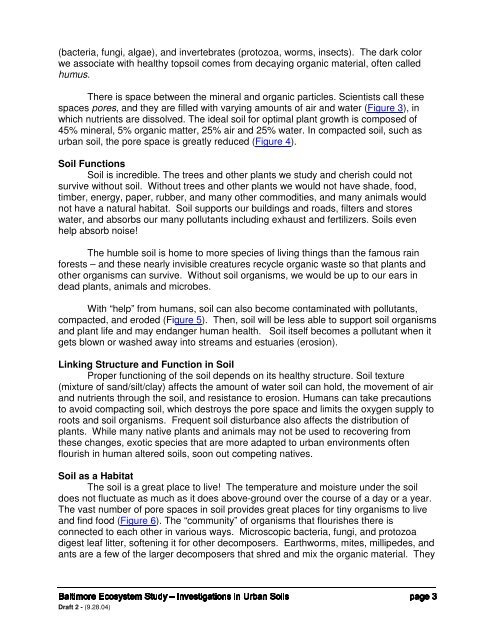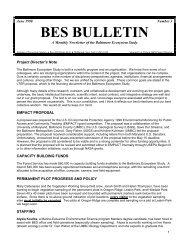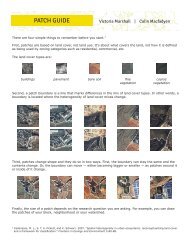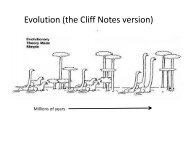Investigations in Urban Soils - Baltimore Ecosystem Study
Investigations in Urban Soils - Baltimore Ecosystem Study
Investigations in Urban Soils - Baltimore Ecosystem Study
You also want an ePaper? Increase the reach of your titles
YUMPU automatically turns print PDFs into web optimized ePapers that Google loves.
(bacteria, fungi, algae), and <strong>in</strong>vertebrates (protozoa, worms, <strong>in</strong>sects). The dark color<br />
we associate with healthy topsoil comes from decay<strong>in</strong>g organic material, often called<br />
humus.<br />
There is space between the m<strong>in</strong>eral and organic particles. Scientists call these<br />
spaces pores, and they are filled with vary<strong>in</strong>g amounts of air and water (Figure 3), <strong>in</strong><br />
which nutrients are dissolved. The ideal soil for optimal plant growth is composed of<br />
45% m<strong>in</strong>eral, 5% organic matter, 25% air and 25% water. In compacted soil, such as<br />
urban soil, the pore space is greatly reduced (Figure 4).<br />
Soil Functions<br />
Soil is <strong>in</strong>credible. The trees and other plants we study and cherish could not<br />
survive without soil. Without trees and other plants we would not have shade, food,<br />
timber, energy, paper, rubber, and many other commodities, and many animals would<br />
not have a natural habitat. Soil supports our build<strong>in</strong>gs and roads, filters and stores<br />
water, and absorbs our many pollutants <strong>in</strong>clud<strong>in</strong>g exhaust and fertilizers. <strong>Soils</strong> even<br />
help absorb noise!<br />
The humble soil is home to more species of liv<strong>in</strong>g th<strong>in</strong>gs than the famous ra<strong>in</strong><br />
forests – and these nearly <strong>in</strong>visible creatures recycle organic waste so that plants and<br />
other organisms can survive. Without soil organisms, we would be up to our ears <strong>in</strong><br />
dead plants, animals and microbes.<br />
With “help” from humans, soil can also become contam<strong>in</strong>ated with pollutants,<br />
compacted, and eroded (Figure 5). Then, soil will be less able to support soil organisms<br />
and plant life and may endanger human health. Soil itself becomes a pollutant when it<br />
gets blown or washed away <strong>in</strong>to streams and estuaries (erosion).<br />
L<strong>in</strong>k<strong>in</strong>g Structure and Function <strong>in</strong> Soil<br />
Proper function<strong>in</strong>g of the soil depends on its healthy structure. Soil texture<br />
(mixture of sand/silt/clay) affects the amount of water soil can hold, the movement of air<br />
and nutrients through the soil, and resistance to erosion. Humans can take precautions<br />
to avoid compact<strong>in</strong>g soil, which destroys the pore space and limits the oxygen supply to<br />
roots and soil organisms. Frequent soil disturbance also affects the distribution of<br />
plants. While many native plants and animals may not be used to recover<strong>in</strong>g from<br />
these changes, exotic species that are more adapted to urban environments often<br />
flourish <strong>in</strong> human altered soils, soon out compet<strong>in</strong>g natives.<br />
Soil as a Habitat<br />
The soil is a great place to live! The temperature and moisture under the soil<br />
does not fluctuate as much as it does above-ground over the course of a day or a year.<br />
The vast number of pore spaces <strong>in</strong> soil provides great places for t<strong>in</strong>y organisms to live<br />
and f<strong>in</strong>d food (Figure 6). The “community” of organisms that flourishes there is<br />
connected to each other <strong>in</strong> various ways. Microscopic bacteria, fungi, and protozoa<br />
digest leaf litter, soften<strong>in</strong>g it for other decomposers. Earthworms, mites, millipedes, and<br />
ants are a few of the larger decomposers that shred and mix the organic material. They<br />
Draft 2 - (9.28.04)<br />
<strong>Baltimore</strong> <strong>Ecosystem</strong> <strong>Study</strong> – <strong>Investigations</strong> <strong>in</strong> <strong>Urban</strong> <strong>Soils</strong><br />
page 3






